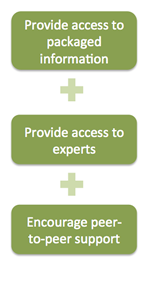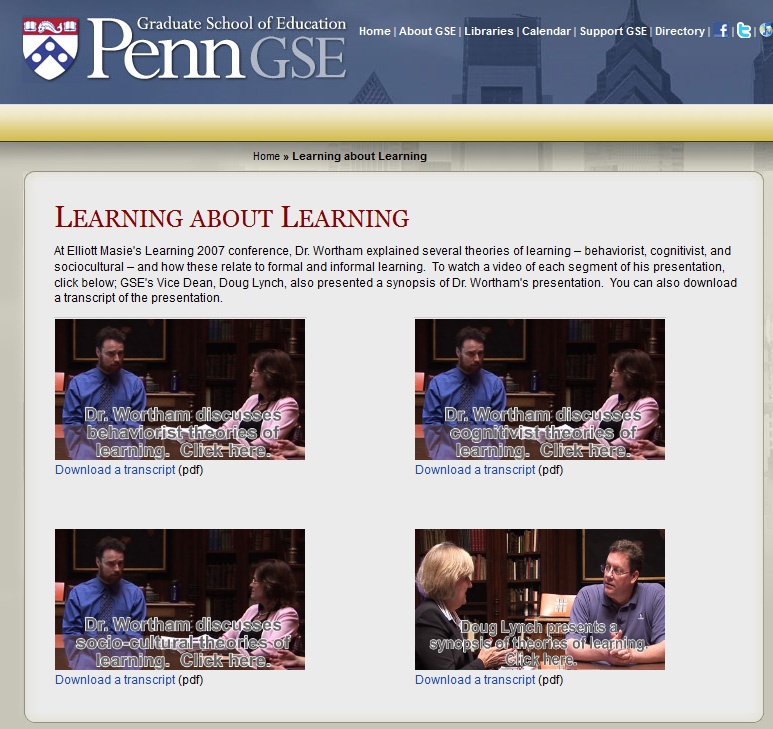The Pro-D Flip — from November Learning by David Truss




Social media and its impact on how we learn in the workplace — from C4PLT by Jane Hart
From DSC:
One reflection that jumped out at me from Jane’s excellent presentation…and that I believe is a universal truth:
If an organization doesn’t respond to changing conditions, needs, desires, preferences, best interests, and/or the requirements of its customers, that organization will diminish in usefulness and will most likely (albeit eventually) go out of business.
I know I’m not introducing a new thought here and the above statement seems very self-evident, but do we heed this advice in corporate L&D? Corporate IT? IT within higher education? In higher education as an industry?
The Smart Worker: Learning continuously with social media — from Jane Hart
Also see:
Why we need less instruction — from Clive on Learning by Clive Sheperd
Excerpt:
Another reason you might back away from instruction as a strategy is because it is more efficient to provide how-to materials at the point-of-need – it isn’t learning that’s required, it’s performance support:

Daniel Christian:
A Vision of Our Future Learning Ecosystems
In the near future, as the computer, the television, the telephone (and more) continues to converge, we will most likely enjoy even more powerful capabilities to conveniently create and share our content as well as participate in a global learning ecosystem — whether that be from within our homes and/or from within our schools, colleges, universities and businesses throughout the world.
We will be teachers and students at the same time — even within the same hour — with online-based learning exchanges taking place all over the virtual and physical world. Subject Matter Experts (SME’s) — in the form of online-based tutors, instructors, teachers, and professors — will be available on demand. Even more powerful/accurate/helpful learning engines will be involved behind the scenes in delivering up personalized, customized learning — available 24x7x365. Cloud-based learner profiles may enter the equation as well.
The chances for creativity, innovation, and entrepreneurship that are coming will be mind-blowing! What employers will be looking for — and where they can look for it — may change as well.
What we know today as the “television” will most likely play a significant role in this learning ecosystem of the future. But it won’t be like the TV we’ve come to know. It will be much more interactive and will be aware of who is using it — and what that person is interested in learning about. Technologies/applications like Apple’s AirPlay will become more standard, allowing a person to move from device to device without missing a beat. Transmedia storytellers will thrive in this environment!
Much of the professionally done content will be created by teams of specialists, including the publishers of educational content, and the in-house teams of specialists within colleges, universities, and corporations around the globe. Perhaps consortiums of colleges/universities will each contribute some of the content — more readily accepting previous coursework that was delivered via their consortium’s membership.
An additional thought regarding higher education and K-12 and their Smart Classrooms/Spaces:
For input devices…
The “chalkboards” of the future may be transparent, or they may be on top of a drawing board-sized table or they may be tablet-based. But whatever form they take and whatever is displayed upon them, the ability to annotate will be there; with the resulting graphics saved and instantly distributed. (Eventually, we may get to voice-controlled Smart Classrooms, but we have a ways to go in that area…)
Below are some of the graphics that capture a bit of what I’m seeing in my mind…and in our futures.
Alternatively available as a PowerPoint Presentation (audio forthcoming in a future version)










— from Daniel S. Christian | April 2011
Addendum on 4-14-11:
A question of balance — by Clive Sheperd
Excerpt:
The issue, as ever, is getting the balance right between taking advantage of new developments as they come available, while continuing to exploit the potential of long-standing approaches.
From DSC:
After looking at some items concerning Connectivism*, I’ve been reflecting upon the following questions:
Thinking of Gonzalez (2004; as cited in Siemens (2005)) description of the challenges of rapidly diminishing knowledge life:
“One of the most persuasive factors is the shrinking half-life of knowledge. The “half-life of knowledge” is the time span from when knowledge is gained to when it becomes obsolete. Half of what is known today was not known 10 years ago. The amount of knowledge in the world has doubled in the past 10 years and is doubling every 18 months according to the American Society of Training and Documentation (ASTD). To combat the shrinking half-life of knowledge, organizations have been forced to develop new methods of deploying instruction.”
Stephen Downes addresses this and points to a possible solution to this phenomenon in his presentation from 3/15/11 entitled “Educational Projection: Supporting Distributed Learning Online.”
Excerpt/slides:
.
I need to put more thought into this, but wanted to throw this question out there…more later…
* From DSC: Some of the items I looked at regarding Connectivism — some directly related, others indirectly-related — were:
Siemens, G. (2005). Connectivism: A learning theory for the digital age. Retrieved from http://www.elearnspace.org/Articles/connectivism.htm.
Downes, S. (2005). An introduction to connective knowledge. Retrieved from http://www. downes. ca/post/33034. Downes noted that this was published in Hug, Theo (ed. ) (2007): Media, knowledge & education – exploring new spaces, relations and dynamics in digital media ecologies. Proceedings of the International Conference held on June 25-26, 2007. November 27, 2007.
Kop, R. & Hill, A. (2008). Connectivism: Learning theory of the future or vestige of the past? International Review of Research in Open and Distance Learning, v9 n3 p1-13 Oct 2008.
Tracey, R. (2009). Instructivism, constructivism or connectivism? Training & Development in Australia, December, 2009. p08-09, 2p. Retrieved from EBSCOhost. ISSN 0310-4664.
Kerr, B. (2007). A challenge to connectivism. Retrieved at http://learningevolves. wikispaces. com/kerr.
Sims, R. (2008). Rethinking (e)learning: A manifesto for connected generations. Distance Education Vol. 29, No. 2, August 2008, 153–164. ISSN 0158-7919 print/ISSN 1475-0198 online. DOI: 10. 1080/01587910802154954
Lisa Dawley. (2009). Social network knowledge construction: emerging virtual world pedagogy. On the Horizon, 17(2), 109-121. Retrieved from ProQuest Education Journals. (Document ID: 1880656431).
Hargadon, S. (2011). Ugh. Classic politics now extends to social networking in education. Retrieved from http://www. stevehargadon. com/2011/03/ugh-classic-politics-now-extends-to. html.
Cross, J. (2001). Crowd-inspired innovation. Retrieved from http://www.internettime.com/2011/03/crowd-inspired-innovation.
Rogers-Estable, M.. (2009). Web 2.0 and distance education: Tools and techniques. Distance Learning, 6(4), 55-60. Retrieved from ProQuest Education Journals. (Document ID: 2017059921).
Marrotte-Newman, S.. (2009). Why virtual schools exist and understanding their culture. Distance Learning, 6(4), 31-35. Retrieved from ProQuest Education Journals. (Document ID: 2017059881).
Hilton, J., Graham, C., Rich, P., & Wiley, D. (2010). Using online technologies to extend a classroom to learners at a distance. Distance Education, 31(1), 77-92. Retrieved from ProQuest Education Journals. (Document ID: 2074810921).
Attwell, G. (2010). Personal learning environments and Vygotsky. Retrieved from http://www.pontydysgu.org/2010/04/personal-learning-environments-and-vygotsky.
10 Steps for Working Smarter with Social Media — from the Centre for Learning & Performance Technologies by Jane Hart
Webinar for Learning & Skills Group, 17 March 2010
Excerpt below:
10 Steps for Working Smarter with Social Media
Webinar for Learning & Skills Group, 17 March 2010

 Workplace Learning is changing!
Workplace Learning is changing!
A number of people, my Internet Time Alliance (ITA) colleague Charles Jennings in particular, have highlighted the fact that training that simply involves filling people’s heads with knowledge, is ineffective and inefficient – as most people forget what they have learnt very quickly. And that online courses, which do pretty much the same, take time, effort and money to develop.
Many are also “over-engineered” solutions – and this often leads to resentment by those who have to spend time to work through courses – when the material could have been provided in a much simpler way. But in fact this whole approach to workplace learning is not sustainable in a world that is moving very fast and where there is need for access to constantly changing information.
On the other hand, although we have now realized – due largely to the work of (my ITA colleague) Jay Cross – that most of an individual’s “real” learning takes place outside formal learning .. continuously … in the workflow … by reading or listening to things, or more significantly in conversations and interactions with other people, L&D have struggled to understand how to harness informal learning, and perhaps understandably often try to force it into the formal model they feel comfortable with it.
But it is in fact, the emergence of social media, that has really begun to make us think differently about the way work and learning is happening. For an increasing number of individuals and groups are using these new technologies in the workplace to connect with colleagues both inside and outside the organisation in order to share ideas, resources and experiences – often under the radar of IT and L&D. This use of social media has become a revolution in the sense that these tools are now in the hands of the employees. So the question is what role does L&D play in all this?
differently about the way work and learning is happening. For an increasing number of individuals and groups are using these new technologies in the workplace to connect with colleagues both inside and outside the organisation in order to share ideas, resources and experiences – often under the radar of IT and L&D. This use of social media has become a revolution in the sense that these tools are now in the hands of the employees. So the question is what role does L&D play in all this?
One key thing to remember is Learning is not the end goal; but is a means to an end. It’s about PERFORMANCE; people doing their jobs (better). In fact it’s all about working smarter. So what is working smarter?
.
Also related:
Five trends in learning delivery in 2011 — from the Chief Learning Officer by Caroline Avey
From DSC:
I’d like to thank:
2/8/11:
Note/correction from my original posting:
Doug Lynch and Stanton Wortham are not at Penn State, but rather they are at the University of Pennsylvania; Elliot Masie is an Adjunct Faculty Member at the University of Pennsylvania.
.
Addendum on 1-20-11:
The future of the TV is online — from telegraph.co.uk
Your television’s going to get connected, says Matt Warman





